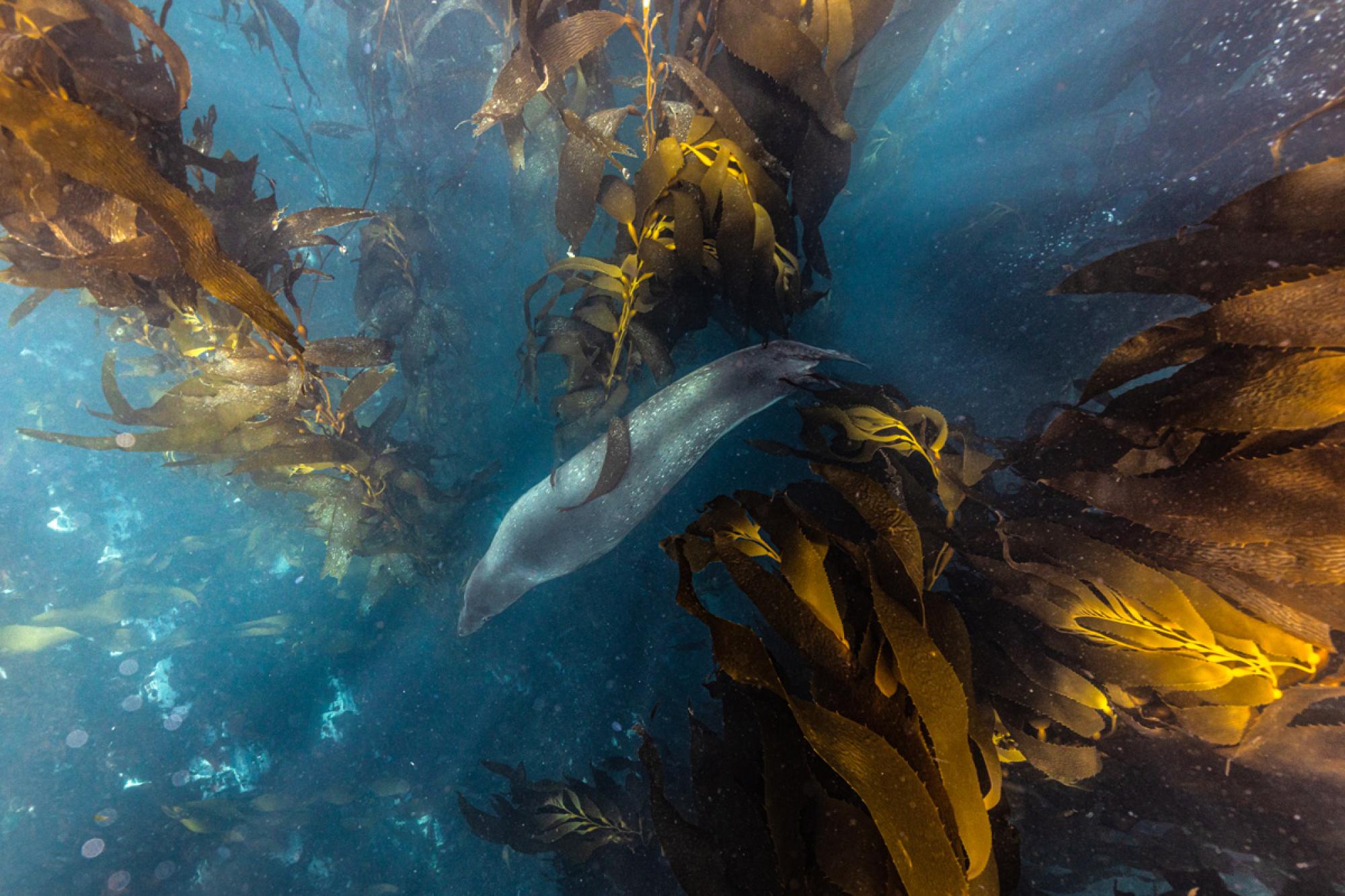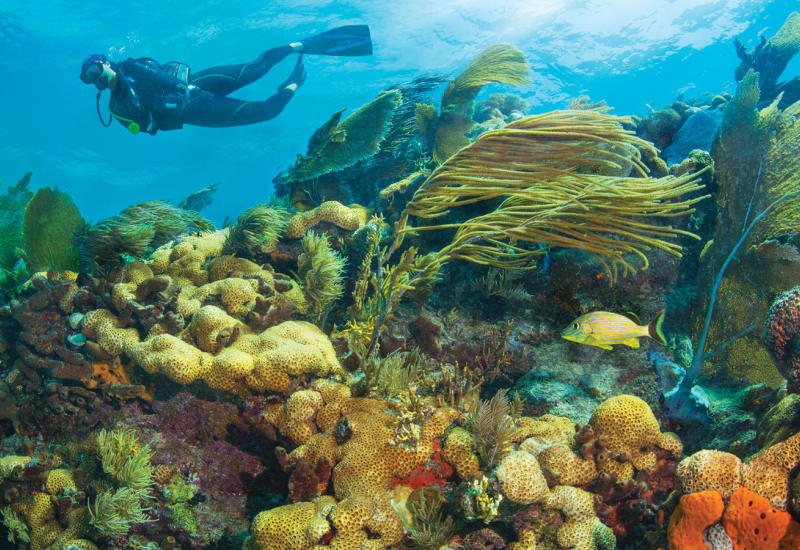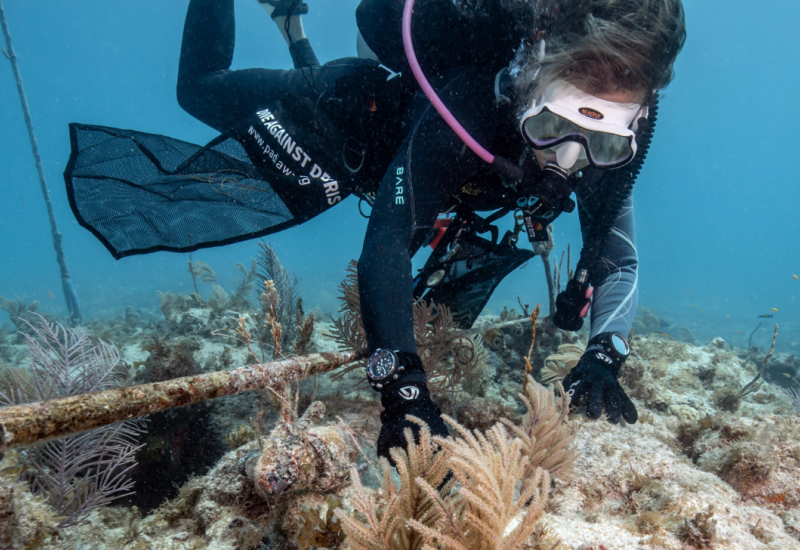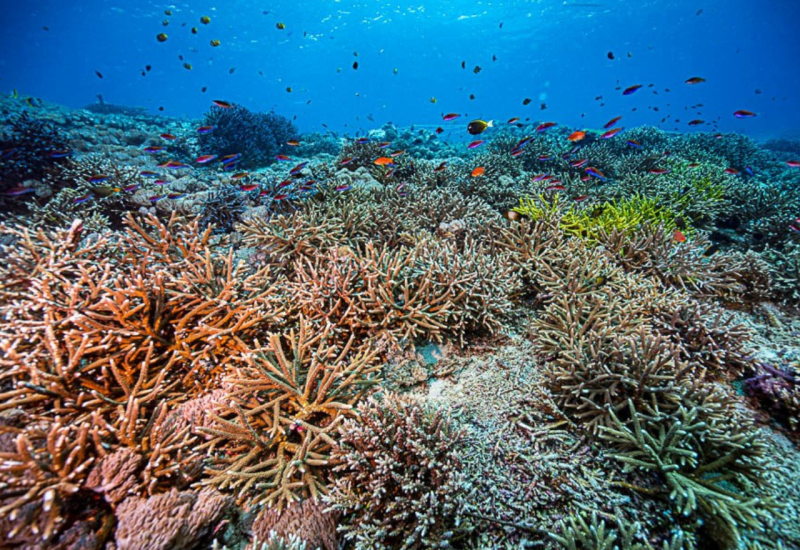Sea Forests of the South: Searching for Kelp in the Southern Ocean
The first couple minutes of the dive are the most painful, before your lips and cheeks go numb. Once you can’t feel your face anymore, you’re free to explore the icy waters until your hands become unbearably frozen (usually about 30 minutes).
In Mary Cerullo’s 2003 book with underwater photographer Bill Curtsinger, Life Under Ice, she writes that the Antarctic continent is the “coldest, driest, windiest, and highest continent”—a place of extremes.
Why would anyone brave subfreezing ocean temperatures in the snow in a drysuit, two undergarments, a 10 mm hood, and 35 pounds of lead that you have to hoist in and out of the Zodiac while being watched by a curious leopard seal and a 4-ton elephant seal? I did it for the kelp forests.
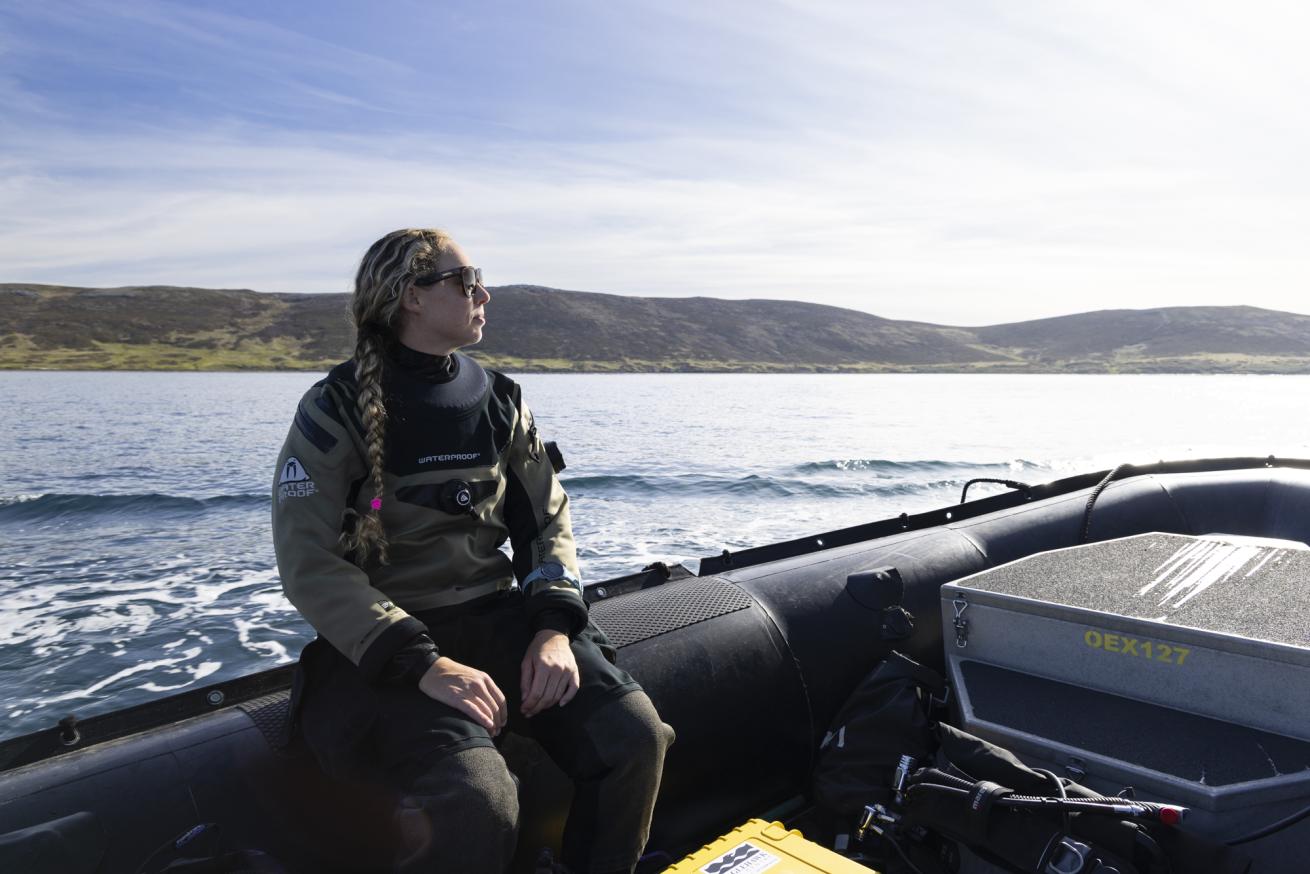
IAN SEGEBARTHThe author
I am an underwater photojournalist currently working on stories about kelp research and conservation on all seven continents. A few years ago, while writing a grant proposal, I read that kelps are found “along coastlines of all continents except Antarctica.” When a lastminute spot opened up on an Oceanwide Expeditions trip to the Falklands, South Georgia and the Antarctic Peninsula, I needed an excuse to go that didn’t make me feel guilty for taking a month off from kelp stories underway in California and Japan. I started researching the Falklands and South Georgia and found that these sub-Antarctic islands do in fact have kelp-lined shores. It was the perfect excuse to swim in the southernmost kelp forests in the world.
Related Reading: The Dark Side of Our Fascination with Antarctica
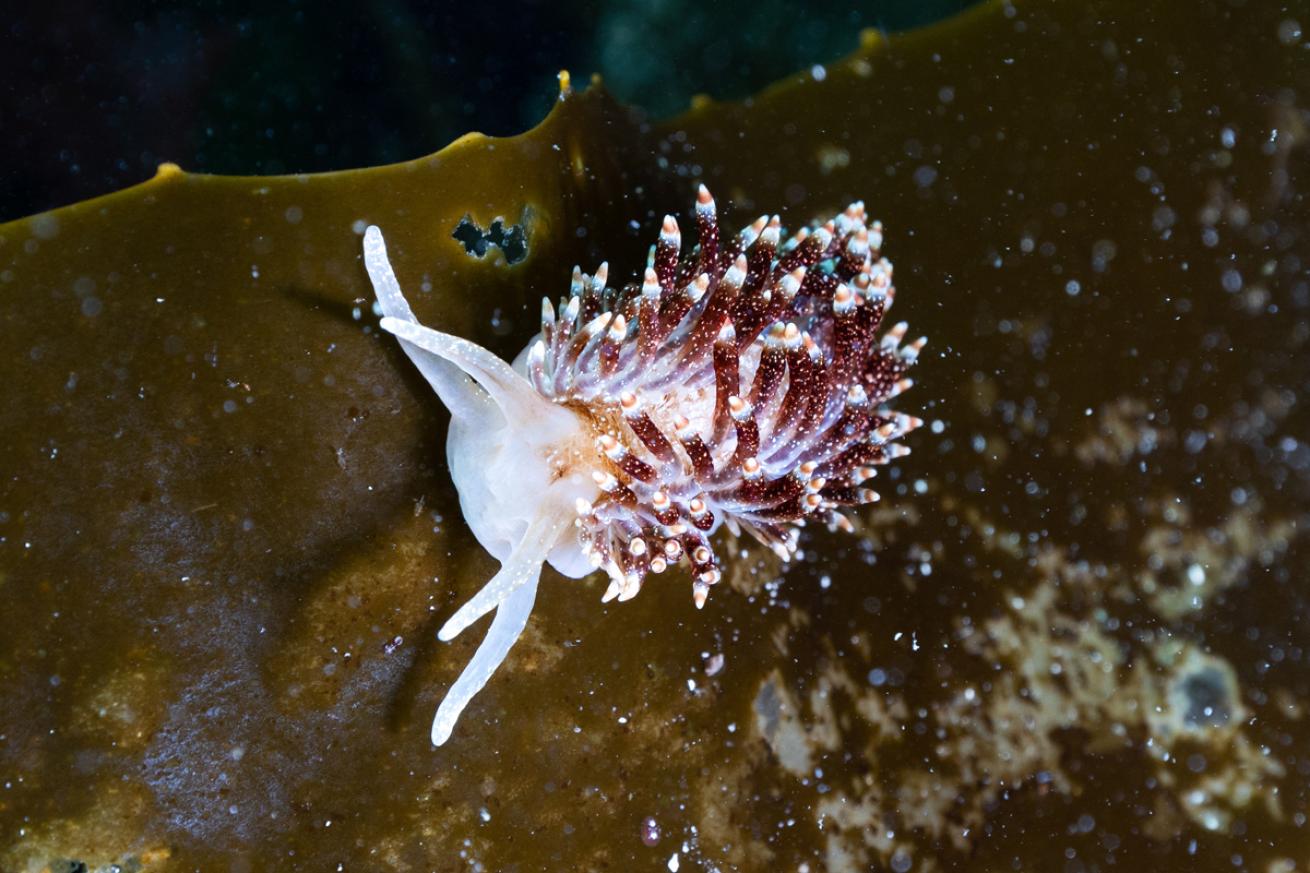
JENNIFER ADLERA Flabellina falklandica nudibranch on a blade of kelp in the Falklands;
The ship, filled mostly with nondiving tourists, was scheduled to leave from Puerto Madryn, Argentina, a few days after I finished a project aboard Bob Ballard’s E/V Nautilus in Hawaii. I returned home for less than 24 hours, swapped my wetsuits for a drysuit and thick undergarments, and hopped on a plane from San Francisco to Buenos Aires, then to Puerto Madryn, ready for the 22- day journey toward the Southern Ocean.
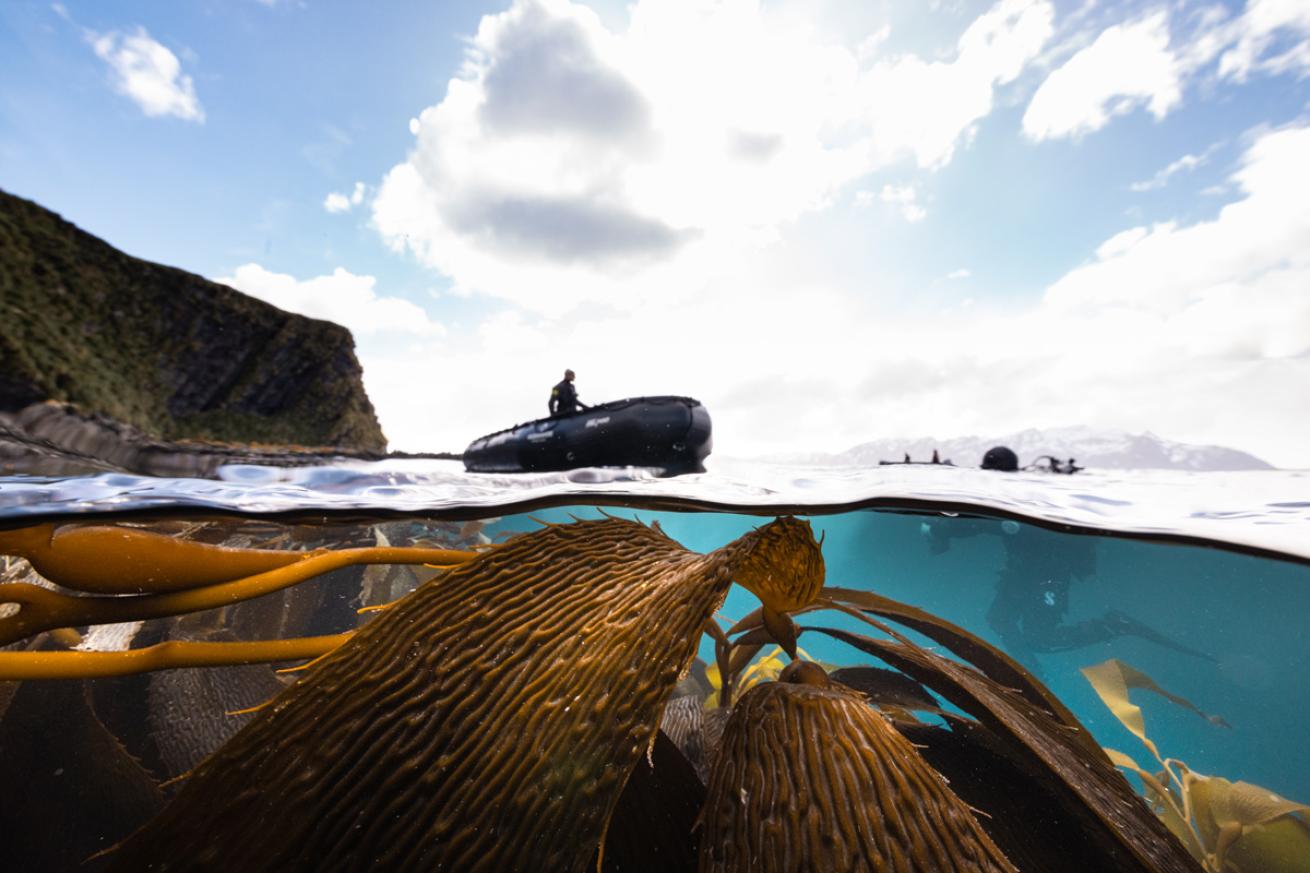
JENNIFER ADLERGiant kelp at Salisbury Plain, South Georgia.
First Impressions
It takes two days by boat from Argentina to reach the Falklands. Before the Panama Canal was completed in 1914, the islands were a strategic location for ships to seek repairs after the rough Cape Horn passage. Nowadays, ship repairs have largely been replaced by fishing, sheep farming and tourism.
If I woke up in the Falklands with no context, I would assume it was Iceland— volcanic mountains emerge from the sea, surrounded by fields of sheep. But the king penguins on a sandy beach with Caribbean-colored water indicate we are not in the Arctic. The Falklands (or Islas Malvinas) is made up of about 740 islands in the South Atlantic Ocean, roughly 400 miles east of Argentina’s coast.
Related Reading: The Arctic Is Acidifying Up to Four Times Faster Than Other Oceans, New Study Finds
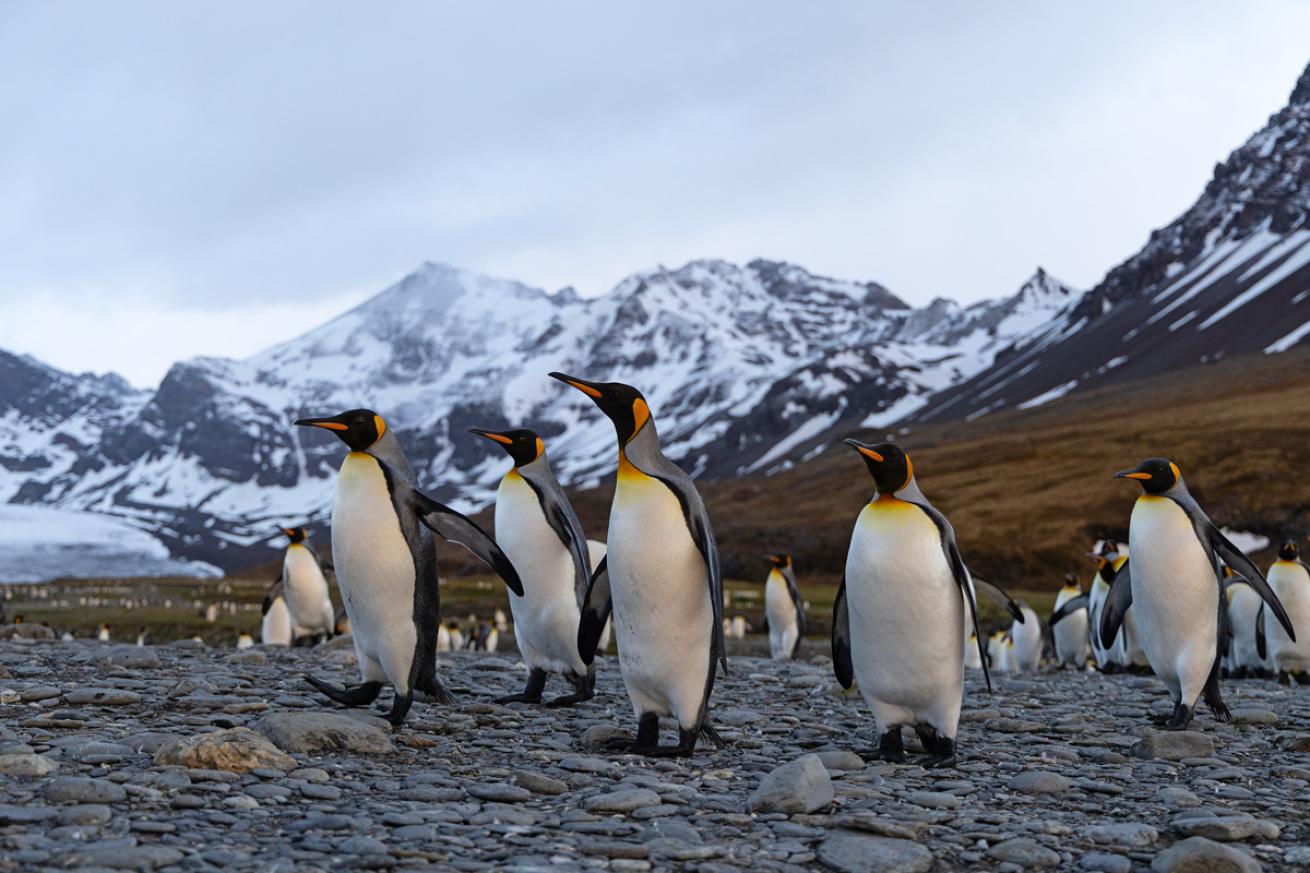
JENNIFER ADLERCurious king penguins shuffle along the beach in St. Andrews Bay, South Georgia, where they can be seen forming giant breeding colonies numbering 150,000 pairs.
Our first few days at sea with following winds had us in high spirits as we arrived at Carcass and Saunders islands in the northwest Falklands. As soon as we arrived, all seven divers aboard our 150-passenger ship back-rolled off the Zodiac into water only 10 degrees colder than it was at home in Monterey, California. It was a bit surreal to be surrounded by the same giant kelp species (Macrocystis pyrifera) this far south. This widespread kelp species is found in temperate waters on both sides of the equator— a 2010 paper in the Journal of Phycology (the study of algae) notes that its taxonomy “has been under constant discussion” for a long time, but it’s considered the same species at all latitudes. How it managed to hop the equator is another question.
The sun filtering through the Macrocystis is golden, and sea stars dot the fronds of several species of kelp, from Lessonia to Durvillaea antarctica. Nudibranchs cling to the kelp blades as they flow in the current, and a sunflower star with 32 legs gracefully glides across red algae and a sandy bottom. I’ve never seen a sunflower star in California— most of them died when sea star wasting syndrome hit the West Coast in 2013— so this sighting is thrilling. As we surface, the golden hues of the kelp give way to green fields on land.
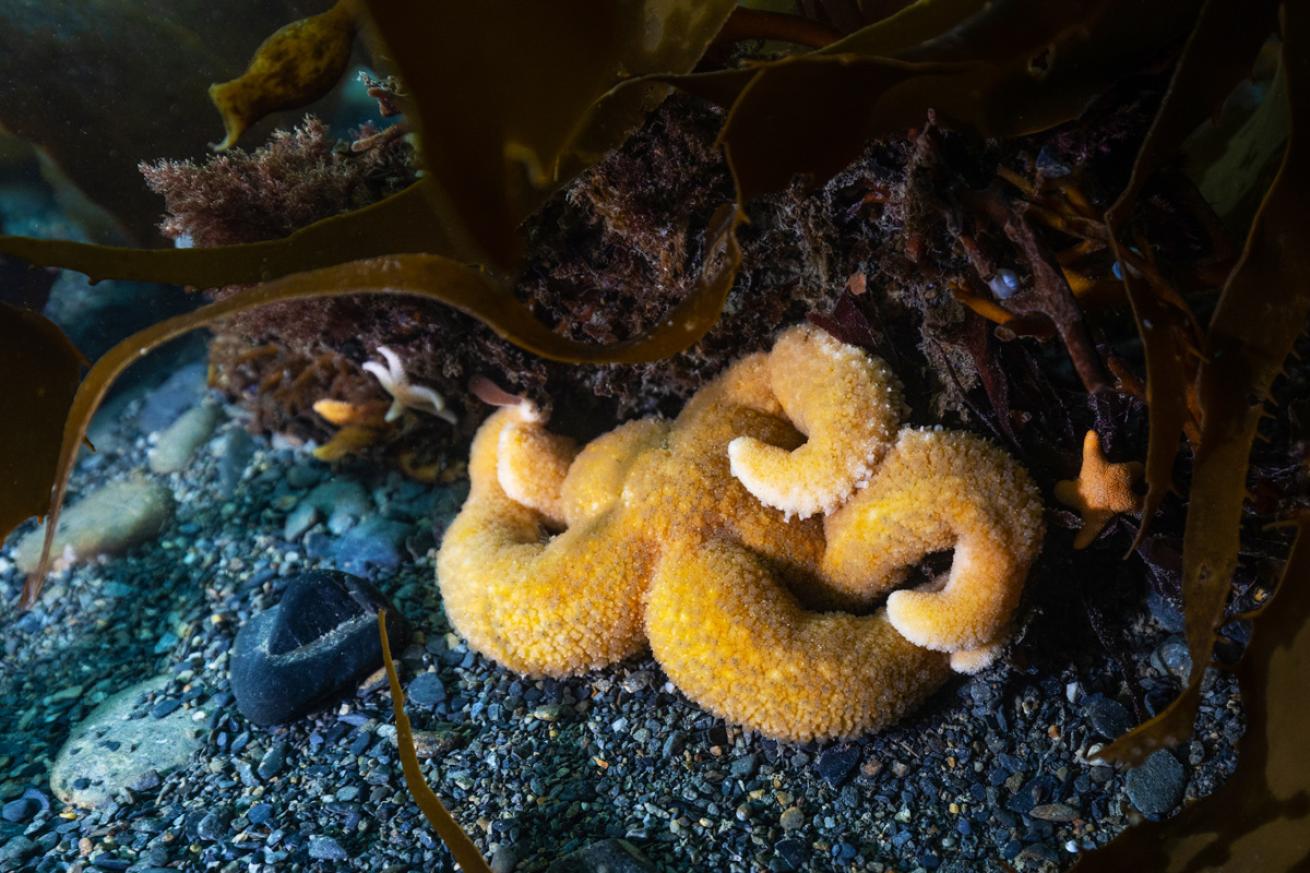
IAN SEGEBARTHA Diplasterias brandti sea star nestles beneath a giant kelp holdfast.
There is a culture of conservation on the islands. While visiting the capital of Stanley, we met a local jeweler who uses inspiration from the sea to create her rings, bracelets and earrings. A flyer in her shop’s window reads “Salmon Free Falklands,” advertising for a community group trying to keep industrial fish farming out of the country. A band of scientists, divers and local volunteers called the Shallow Marine Surveys Group facilitates kelp surveys and marine research in the archipelago.
While walking along the waterfront street in Stanley, we started chatting with a man painting the fence in his front yard. His name is David Eynon, and it turns out he wrote the only guide to diving in the Falklands—Beneath Falkland Island Waters. In the book, Eynon writes about the shipwrecks, marine life and dive sites in the Falklands from his 40 years of experience diving there, beginning with his search for the wreck of the Conquimbana in 1981. We could’ve easily spent the day hearing about his adventures, but our ship was ready to head east. Seas built, and any windows without blinds were covered with old charts to protect the birds from flying toward the ship’s indoor lights after sunset. The Falklands felt remote, but we were headed farther.
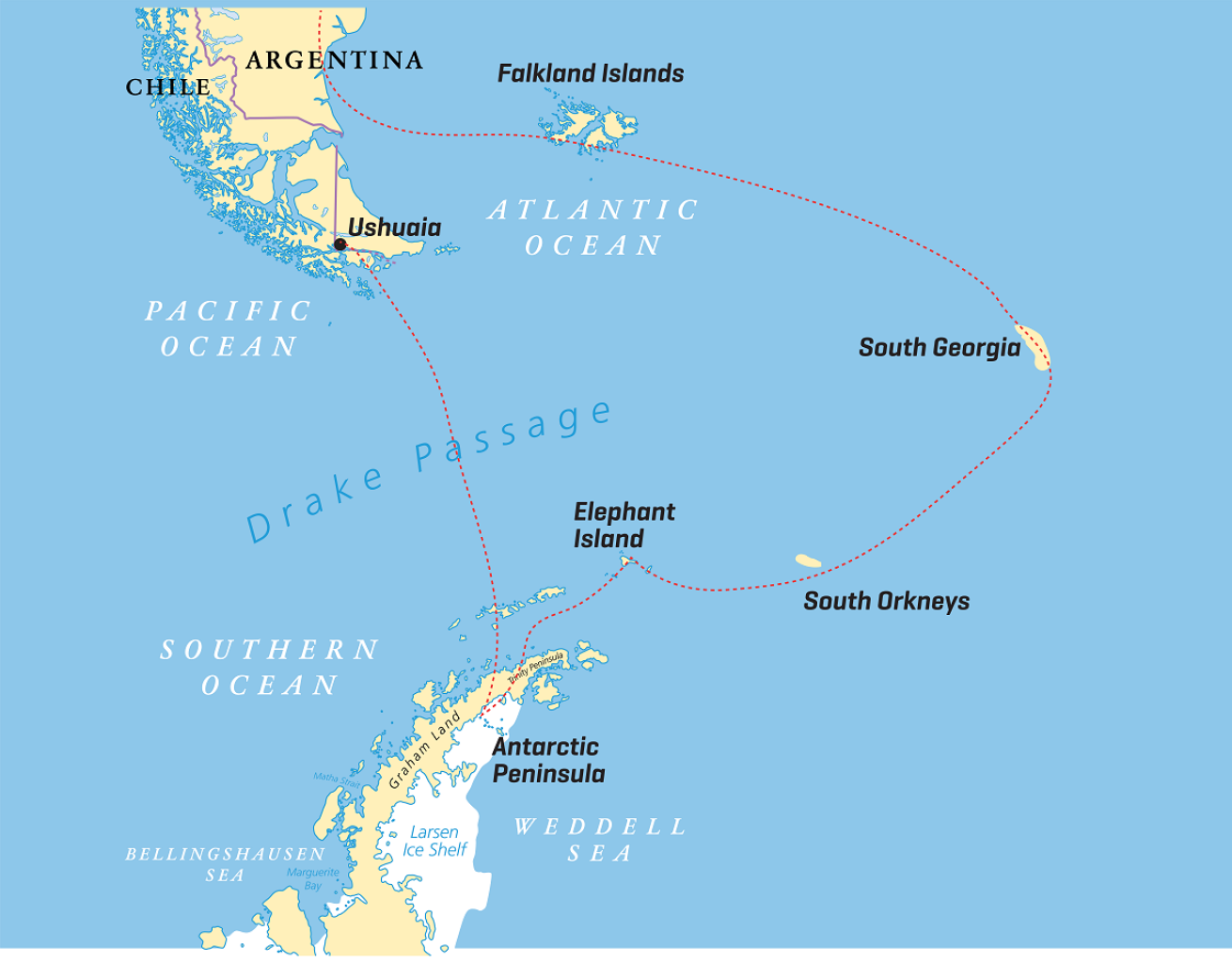
RAINER LESNIEWSKISouth Sea Map
3,795
Total nautical miles traveled
22
Days aboard a ship (8 completely at sea)
13
DIVES
28
DEGREES
Was the lowest water temperature we dived in the Antarctic Peninsula
7
METERS
Maximum wave height (while crossing the Drake Passage)
60-65
KNOTS
Max winds
Cold-Water Paradise
When British explorer Capt. James Cook claimed South Georgia Island, roughly 1,100 miles east of South America’s southernmost tip, for Britain in 1775, he wasn’t enthralled, writing in his journal that it was “a country doomed by nature never once to feel the warmth of the sun’s rays, but to lie buried under everlasting snow and ice.”
The island’s human population of 12 is a proper indicator of the living conditions for people, but it is home to the greatest concentration of marine mammals and seabirds on the planet. You can feel this in your bones as you approach on a Zodiac. The beaches are absolutely alive with an interesting, cacophonous chorus of grunts, burps, toots, sneezes, the catlike whines of fur seals, and penguins that sound like kazoos at a Fourth of July parade. When you land onshore, baby elephant seals with huge eyes and endearing wrinkles galumph toward your toes and you have to do your best to keep the lawful distance.
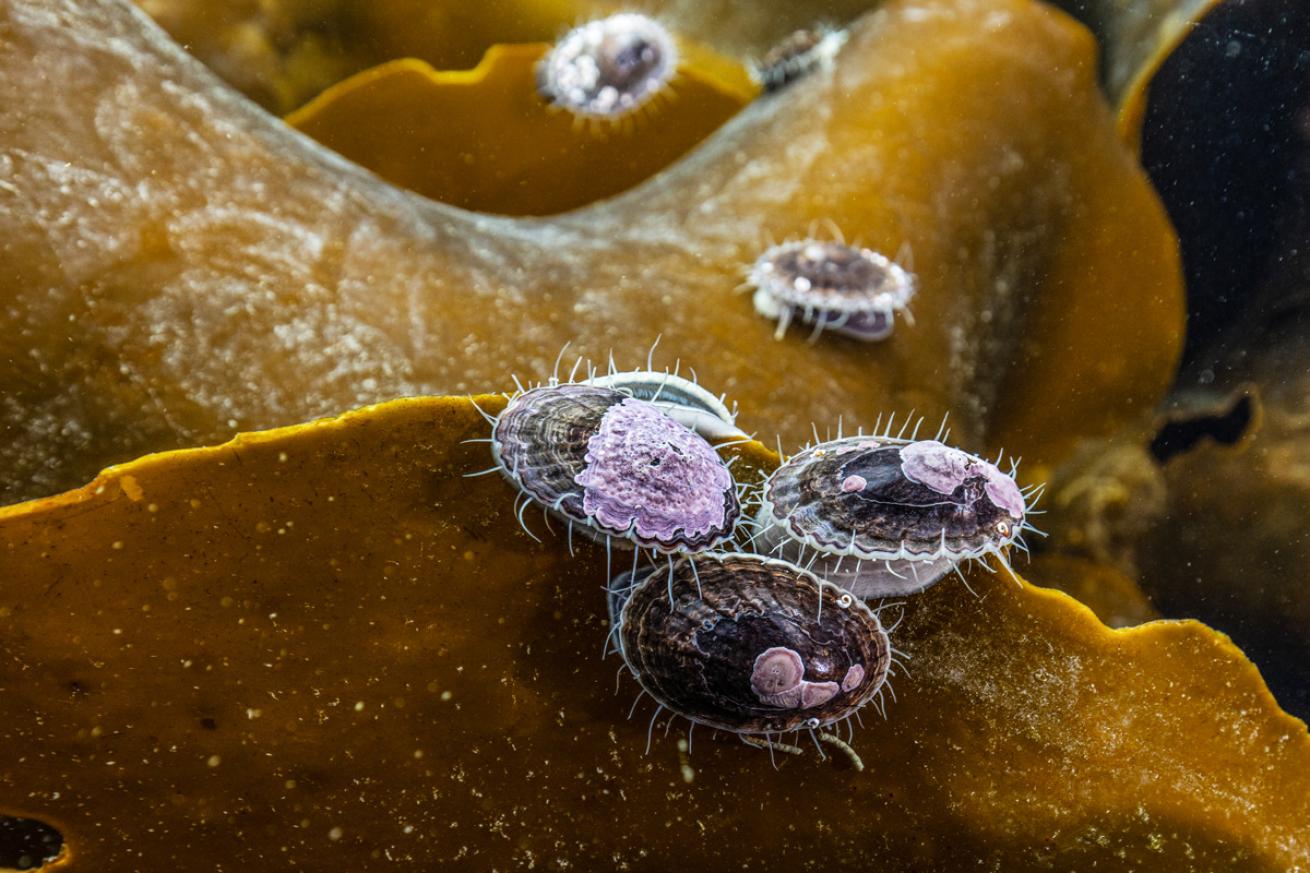
IAN SEGEBARTHKeyhole limpets cling to a piece of brown algae (Himantothallus grandifolius).
South Georgia and the Sandwich Islands are surrounded by a half-millionsquare- mile marine protected area (established in 2012)—about twice the size of Texas. But the history is more gruesome— humans slaughtered about 175,000 whales in South Georgia between 1904 and 1965. Grytviken, the former center of whaling, is a living museum in the middle of the island’s east coast. Grytviken directly translates to “pot cove” in Swedish and Norwegian, referencing the cauldrons they used to process whales. It’s now home to a post office, a museum, and a British Antarctic Survey research station, but the church and many of the whale processing buildings are still there too. It feels a bit creepy or haunted, but what you really have to worry about are the fur seals that lurk around every corner. Despite being cute, they are fast and feisty, and you don’t want to get too close, especially to the “beach masters.” These high-testosterone males have staked territorial claim to a section of the shoreline protecting their harems.
The only way to get to South Georgia is on a ship, usually a two-day crossing from the Falklands. There is no way to land a plane on the island. After visiting Grytviken, all of our diving was on the sheltered northeastern side of the island—you generally can’t land on the southwestern side because it’s too windy, although in 1916, explorer Ernest Shackleton did land in King Haakon Bay on the south side of South Georgia when he arrived by dinghy from Elephant Island. This was not by choice, and the 36-hour trek over the mountains to Grytviken almost killed him and his men. Today, from the comfort of an icebreaker, bays on the east side are a (cold-water) diver’s paradise.
Related Reading: Stunning Photos from the First Antarctic Dive Expedition in Two Years
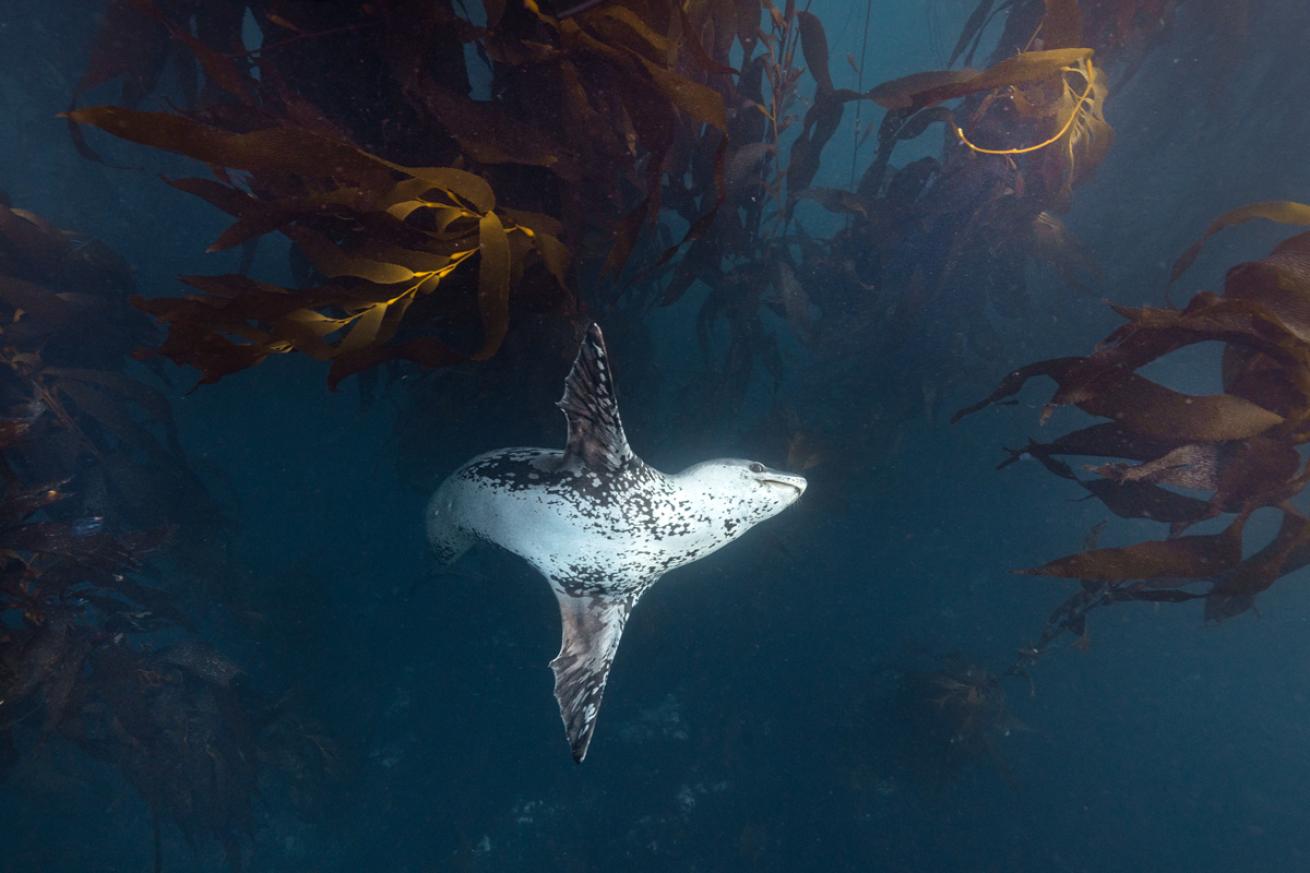
JENNIFER ADLERA leopard seal playfully backflips in a South Georgia kelp forest.
South Georgia lies at a latitude of 54 degrees south, just outside the boundary established by the Antarctic Treaty at 60 degrees south. But it’s far enough south that the water is cold, ranging from 32 to 34 degrees Fahrenheit on our dives during the early Southern Hemisphere summer. Tourism (and therefore diving) is nonexistent in the winter.
Submerging at Godthul, just east of Grytviken, we found the most beautiful, thick, towering kelp forest I’ve ever seen—the Macrocystis grew on a steep wall, extending well past 100 feet deep. This is again the same kelp species found in California, but here it grows below snow-covered peaks. At home, we are swimming near the northernmost part of its range, and here we are at its southernmost occurrence. But at home, the kelp is disappearing. “South Georgia is a global rarity, an ecosystem in recovery,” says David Attenborough in a documentary about the island. The water was clear and the bottom blanketed with thick, leathery brown algae (Himantothallus grandifolius), cascading down into the abyss. Kelp clams and keyhole limpets clung to the fronds. My frozen thumbs were the only thing that made me surface.
Our dive at Salisbury Plain was our last chance to see a leopard seal in the kelp. We spent as long as we could bear the cold searching for her—female leopard seals often return to the same location, and our guides have seen her here for years. As we sullenly swam back to the Zodiac and started to pass up our gear, she emerged through the kelp. It was breathtaking. She effortlessly swam through the Macrocystis forest, swirling and stealthy. She was big but slender, and endlessly curious. She repeatedly swam up to us until she was within about 10 feet, then backflipped and twirled away. She reminded me of Toothless from How to Train Your Dragon, her mouth extending behind her eyes—leopard seals can open their jaws 160 degrees, more than six times wider than a human jaw.
After swimming with the leopard seal, we surfaced to katabatic winds funneling from the glacier. This far south, winds can pick up quickly. The weather can turn on a dime—perfect preparation for heading farther south to the Antarctic Peninsula.
The Ice Continent
Designated in 2000, the Southern Ocean is the fifth and newest ocean. It includes the sea below 60 degrees south latitude and completely encircles Antarctica. It’s separated from other oceans by the largest ocean current in the world, the Antarctic Circumpolar Current. It is the second smallest ocean but the greatest absorber of heat because it’s so turbulent. At only 15 percent of the world’s total ocean surface, the Southern Ocean absorbs twice as much carbon dioxide as the Amazon Rainforest. As a diver, just know that it is cold and unpredictable.
Before we jump in for our last dive at Cierva Cove, ice is forming at the surface, a thin, delicate crystal that moves with the wind’s ripples. Each hexagon is a few inches across, perfect like my greatgrandmother’s white tatted snowflake ornaments. Our gear is covered in a building layer of snow, and my hands are already frozen.
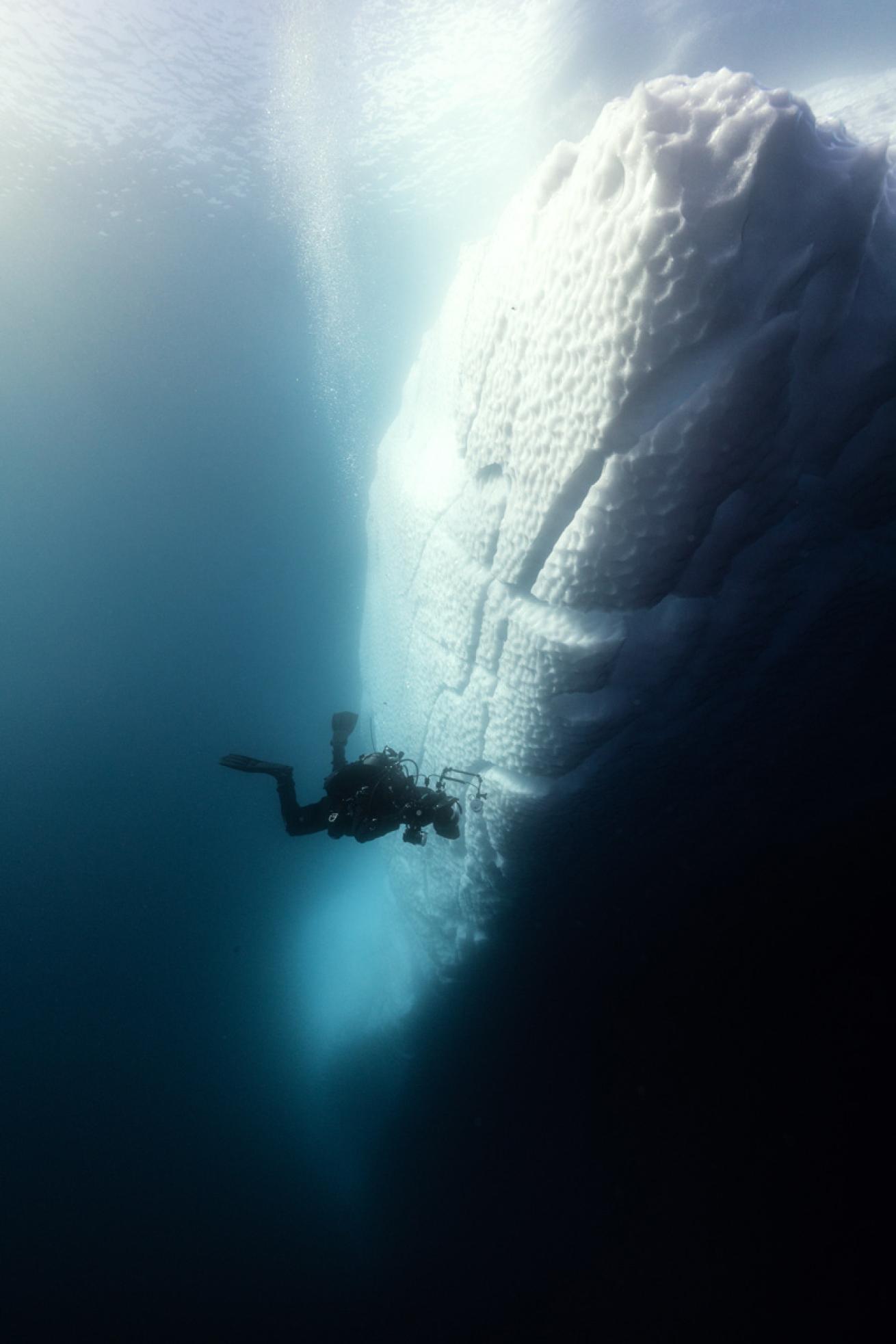
JENNIFER ADLERPhotographer Ian Segebarth films a ctenophore at the edge of an iceberg at Portal Point, Antarctica.
The Antarctic continent is 99 percent ice. Entire mountain ranges lie under what looks to us like a white plateau. In her book Terra Incognita: Travels in Antarctica, Sara Wheeler calls it “a bleached Sahara.” Millions of icebergs break off from glaciers and drift with the currents every year, most headed northeast on the “glacier highway” between the Antarctic Peninsula and the South Orkney Islands. We jump into the 28-degree water to focus on just one. In a place of extremes, it’s cathartic to concentrate on the details of a single chunk of floating ice.
As I hang suspended a few meters away, the iceberg looks white. But up close, it’s covered in a clear layer of ice and puckered like a golf ball. It’s also peppered with rocks, ranging in size from small pebbles to the size of my palm. I think of how long this hunk of ice (as part of a glacier) must have taken to build up in the dry Antarctic continent before it made its way to sea… just to melt back into the ocean.
Up close, the golf-ball-like divot patterns and deep cracks are gorgeous, but to truly appreciate an iceberg, you need to swim away from it for perspective. That’s when you can start to make out the bluish glow emanating from below and its scars forming crisscrossing patterns into the depths. At its edges, a ctenophore pulses, its cilia reflecting a rainbow of colors as it moves through the almost frozen water.
The icebergs are beautiful, but I was excited for the wall dives, where the leathery brown algae Himantothallus drapes into the depths, along with red and green algae of all types. I’d researched the sea star Labidiaster annulatus before the trip and was hoping to find one. We finally find the beast of a star on a steep wall below Shag Rock at 60 feet deep. The 2-footwide starfish has 50-plus arms that look like fuzzy brown pipe cleaners twisted into curls. It could easily be confused for an octopus with way too many legs—or an alien. Unlike most starfish that move along the bottom to evert their stomachs onto sea urchins, mussels and other sessile creatures, this starfish can snatch unsuspecting fish straight out of the water.
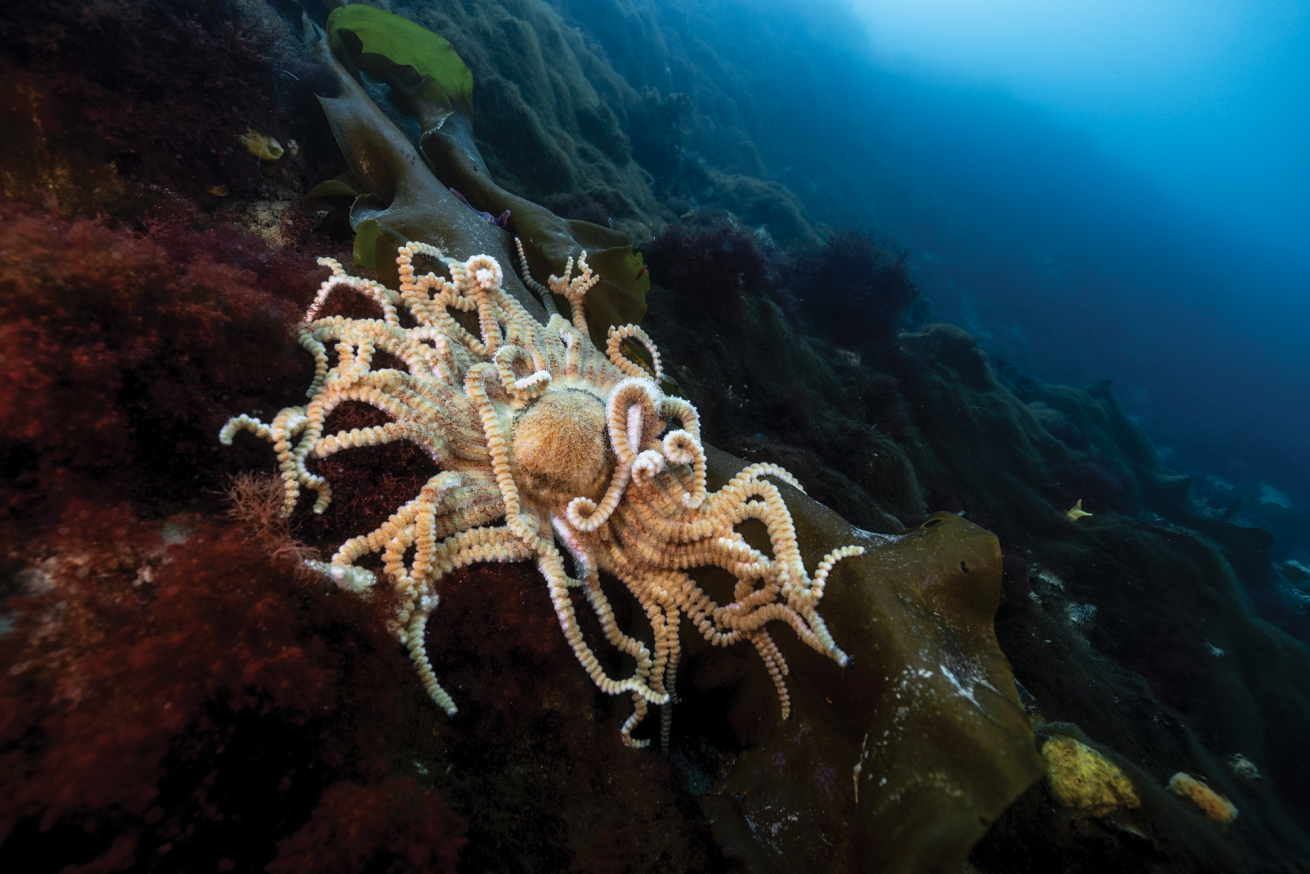
JENNIFER ADLERa 2-foot-wide Antarctic sun star (Labidiaster annulatus) hangs on a wall at 60 feet in Paradise Bay.
Final Frontier
My great-grandmother was 7 years old in 1917, when Ernest Shackleton returned from his final expedition to Antarctica. He and his men sailed in a wooden ship, ate mostly seals and penguins, and slept in sleeping bags that were usually frozen. In his book South, Shackleton writes about eating a young Ross seal that they shot on the ice floe: “He was a young male and proved very good eating, but… made little more than a square meal for our twenty-eight men, with a few scraps for our breakfast and tea. The stomach contained only amphipods about an inch long.” I imagine them dissecting the stomach contents, for science, after their meal.
Related Reading: How Much of the Ocean Has Been Explored? 17 of Your Ocean Questions, Answered.
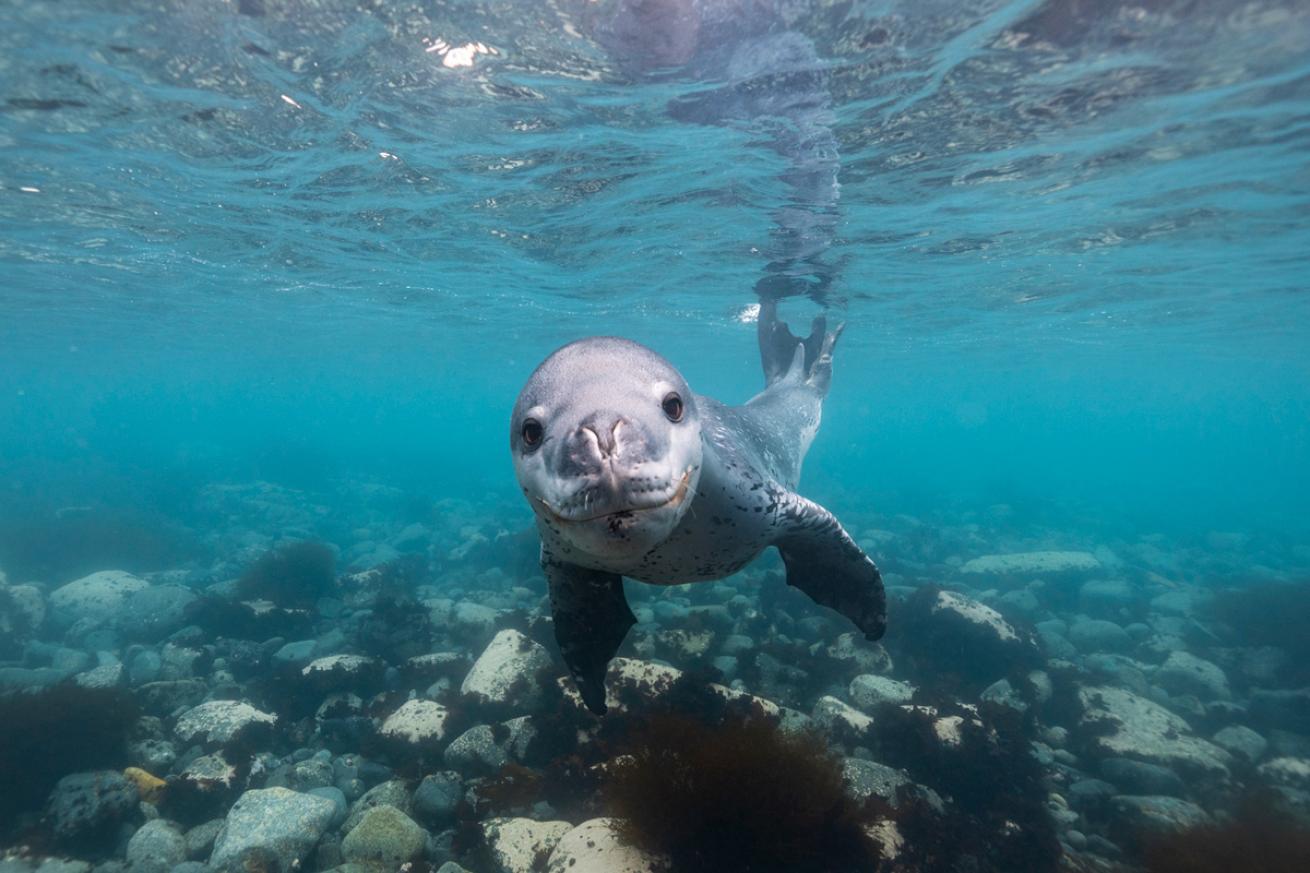
JENNIFER ADLERA leopard seal investigates the camera near Half Moon Island
The first woman didn’t set foot on Antarctica until 1935, the year my greatgrandmother became a mother. Today, her daughter (my grandmother) could go on a cruise to the southernmost continent, sleeping in a heated cabin with room service, hot water, a TV and fivestar meals (that don’t include investigating the stomach contents of your dinner).
After early explorers felt they had enough of the Arctic, Antarctica was the final frontier. For me, it still was— for diving. I wanted to see kelp at its extremes and to photograph a leopard seal in the kelp forest instead of in the icy areas surrounding the peninsula. The 1959 Antarctic Treaty states that Antarctica is a shared space “for peace and science.” Several countries currently claim to own part of Antarctica, including Chile, Argentina and the UK, whose claims overlap on the peninsula. Each of those countries has bases on the peninsula that collaborate on scientific research.
I hope we can keep Antarctica peaceful and protected in perpetuity. As a scientist myself, the research element is important, but I also agree with Wheeler: “We came to probe the Antarctic’s mystery, to reduce this land in terms of science, but there is always the indefinable which holds aloof yet which rivets our souls.” There’s something about being there, about immersing in the bone-chilling water, looking into the eyes of a leopard seal, that changes you.

